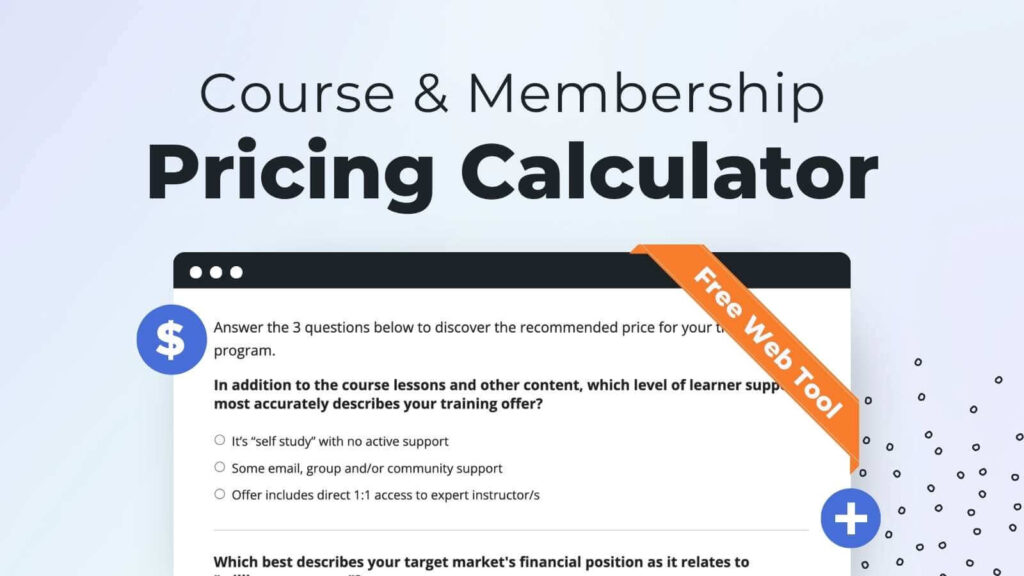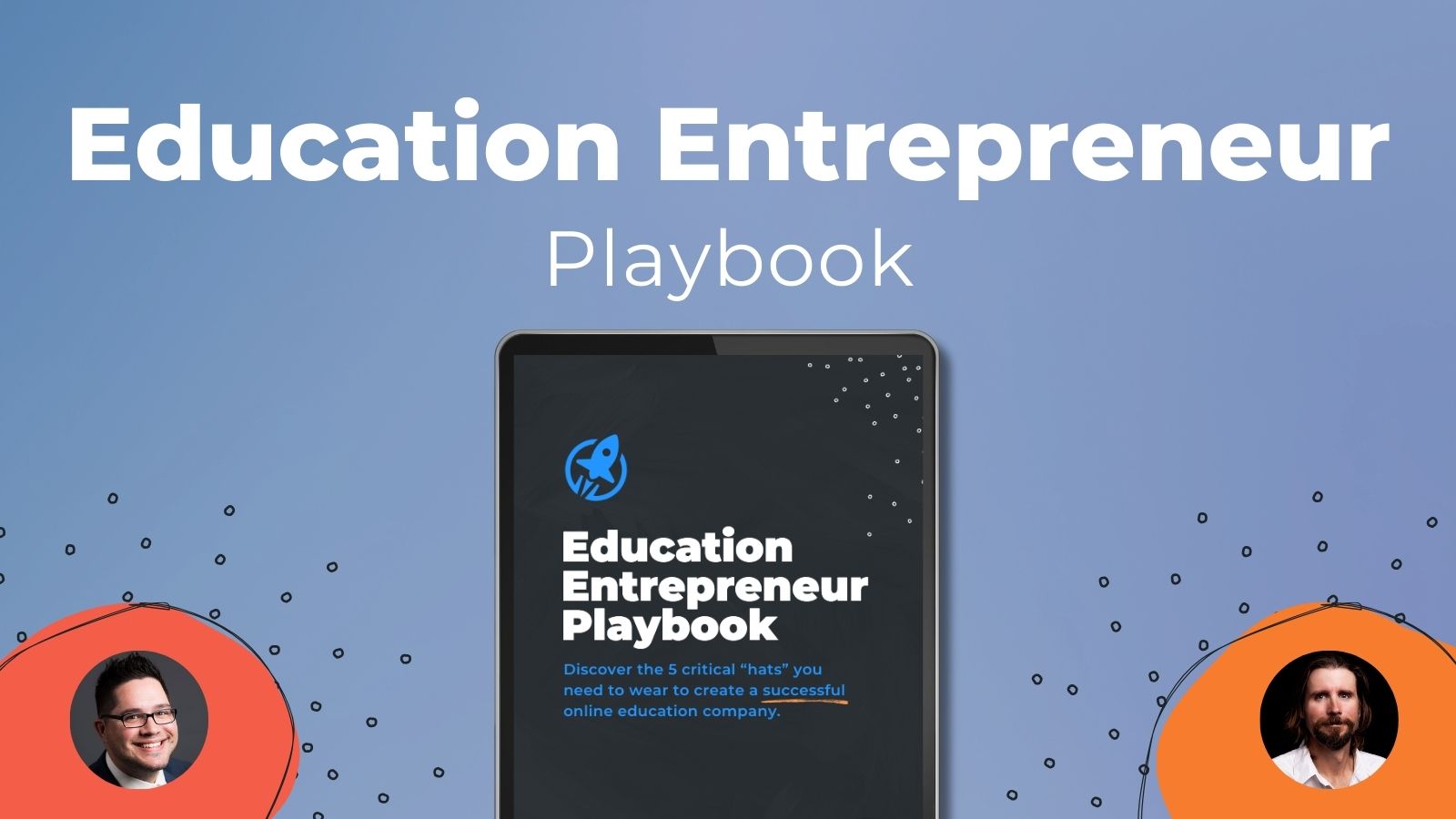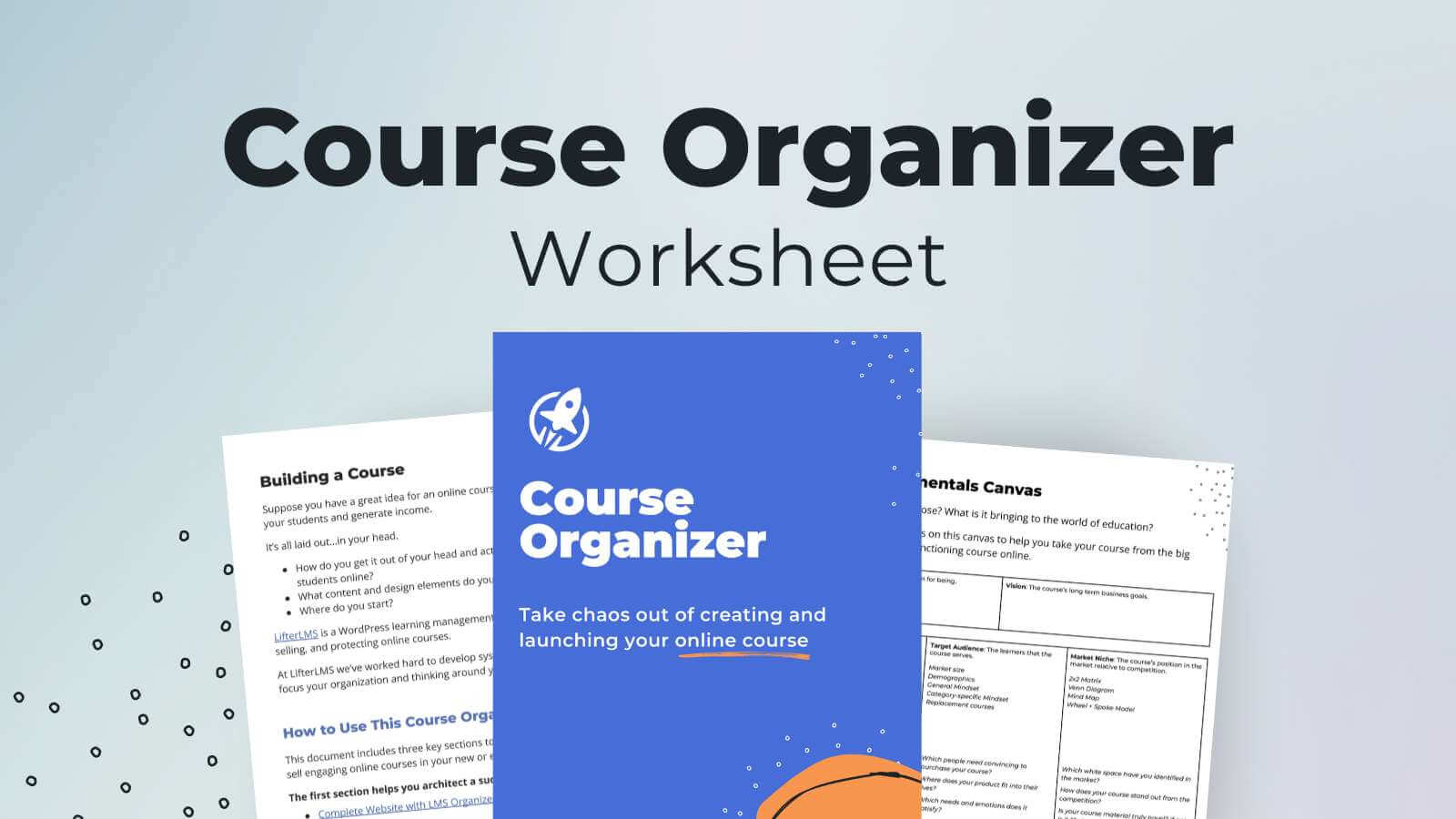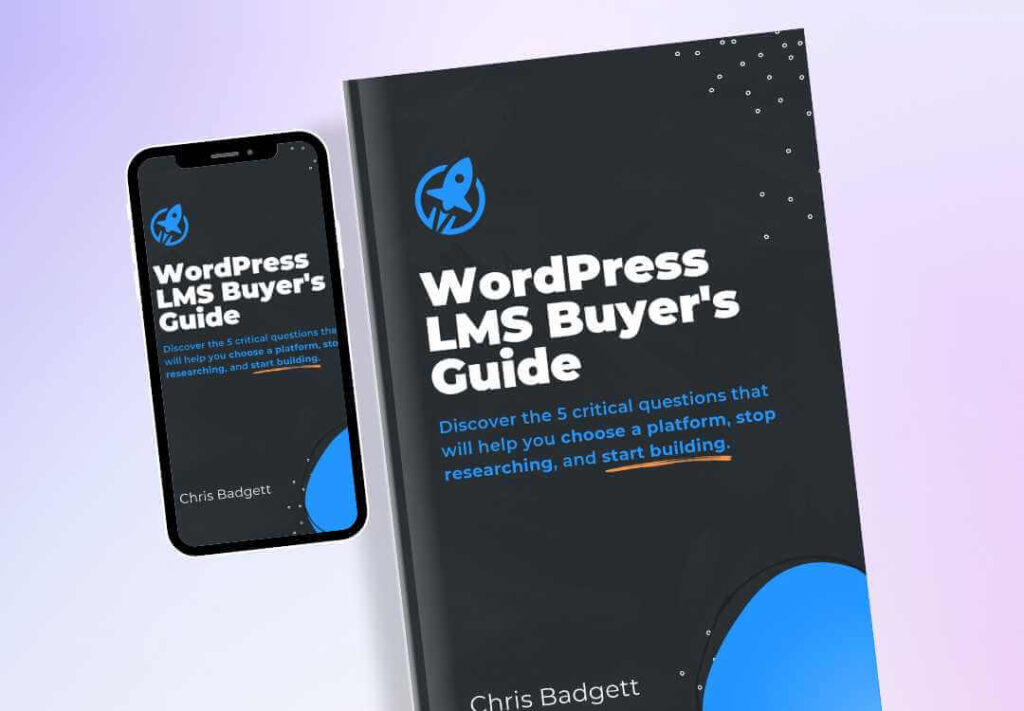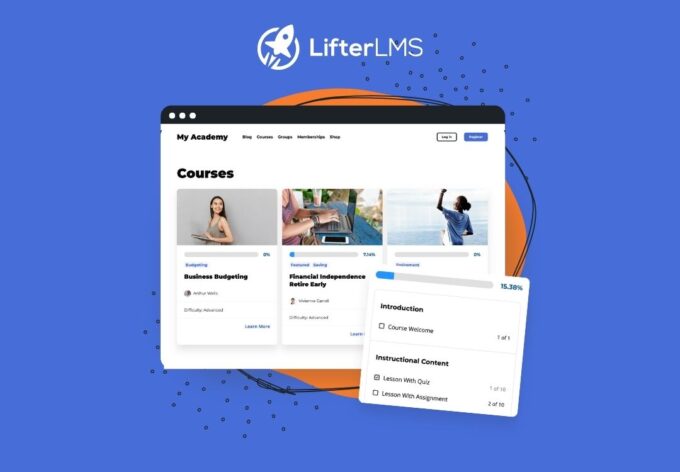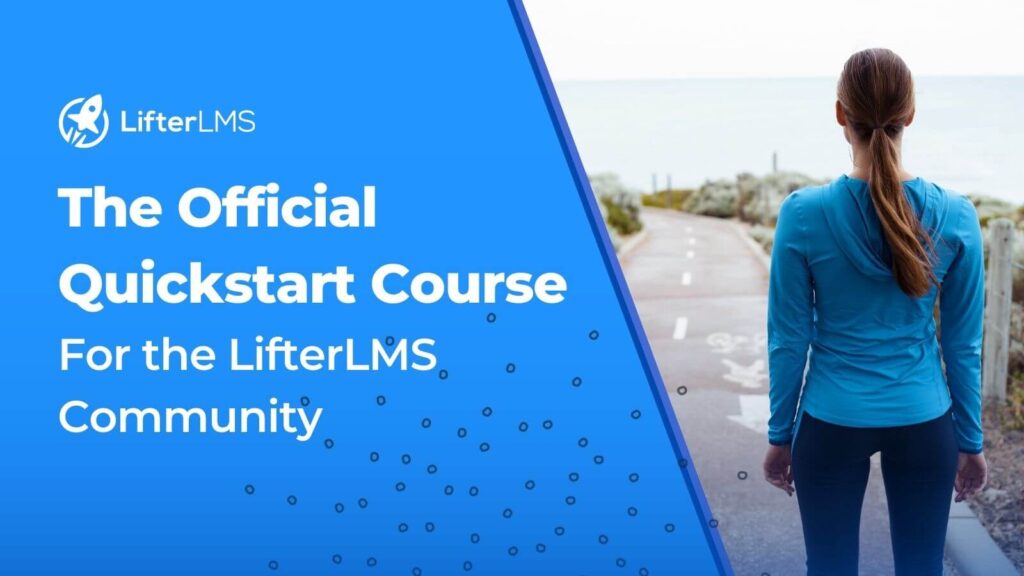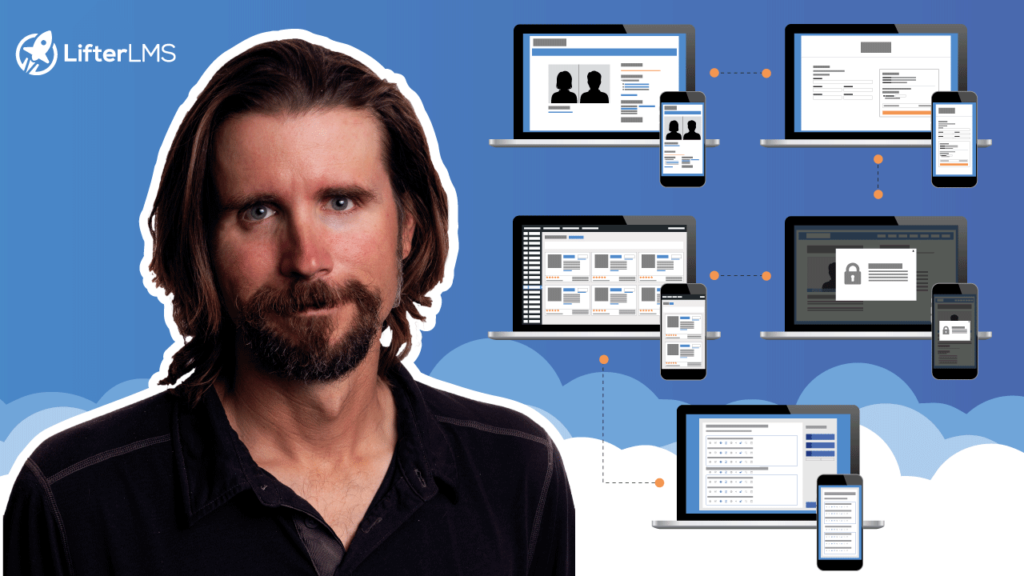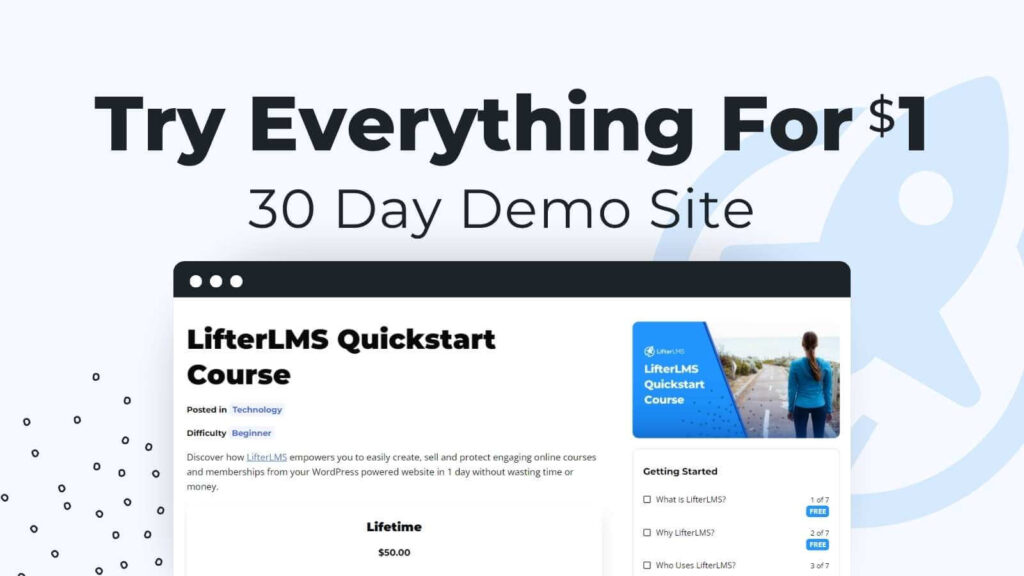In this episode of LMScast, we have the exceptional Yoga master Cate Stillman from yogahealer.com, and our host is Chris Badgett. She started in 2007 as a curriculum creator and instructor by guiding people on a healing journey with Ayurveda & Yoga, an ancient Indian medical practice through her niche medical LMS for healthcare. Cate has emerged as an evolutionary thought leader, global tribe builder and author in the field of re-wilding humans, orienting towards meaning and purpose, and getting deeply invested in life.
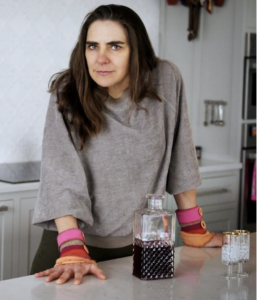
What is Ayurveda? It is about unlocking the full potential of the human body, the most complex and advanced system known to man. Cate works mostly in the US and one of her challenges is to translate ancient ideas in a more palatable way for her modern receivers who are set in a completely different cultural and geographical setting.
Here is a point to pick up for course creators who are teaching difficult topics to their learners. Make the concept as simple and familiar as possible. So, Cate tries to describe everything in a more scientific manner with common words and uses less and less Sanskrit (the language in which the ancient terms are formulated).
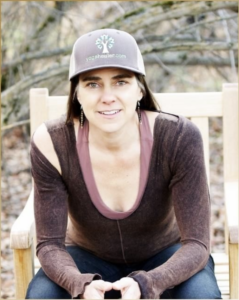
Cate introduces newcomers to Ayurveda to groups who are already practicing at an advanced level. So, that is how they are quickly immersed into healthier living by meeting people with healthier habits all around them. Fasting is one of the most important aspects of healing. It may be daily or seasonal.
One of the key benefits of her courses and why she chose to teach yoga online is that people with illnesses come to develop a healing process that is less dependent on medicines. Human beings are habit-driven and good habits eventually pay up by allowing your body to restore itself.
For course creators, here is another insight from her teaching methods. She believes that people cannot keep concentration on someone talking for more than a few minutes, maybe 5 mins at max. So, she uses visual learning in her teaching as much as possible and draws on a screen to make the learning experience more engaging.
Here’s Where To Go Next…
Get the Course Creator Starter Kit to help you (or your client) create, launch, and scale a high-value online learning website.
Also visit the creators of the LMScast podcast over at LifterLMS, the world’s leading most customizable learning management system software for WordPress. Create courses, coaching programs, online schools, and more with LifterLMS.
Browse more recent episodes of the LMScast podcast here or explore the entire back catalog since 2014.
And be sure to subscribe to get new podcast episodes delivered to your inbox every week.
Episode Transcript
Chris Badgett: You’ve come to the right place if you’re looking to create, launch and scale, a high-value online training program. I’m your guide, Chris Badgett. I’m the co-founder of LifterLMS, the most powerful learning management system for WordPress. Stay to the end, I’ve got something special for you. Enjoy the show.
Chris Badgett: Hello, and welcome back to another episode of LMS cast. I’m joined by a special guest, her name is Kate Stillman. She’s from yogahealer.com. Welcome to the show, Kate.
Cate Stillman: Hey, thanks, Chris. Glad to be here.
Chris Badgett: When did your journey as a what I call it education entrepreneur, somebody who felt a calling to help people, you know, particularly online? When did that start for you? What year were we at?
Cate Stillman: Yeah, so I started. I mean, it depends on how you define online. So I started a website and a Constant Contact, if you remember those guys, email, you know, basically like email blog type of conversation with my audience in 2001. In San Francisco, and our first online courses, 2007.
Chris Badgett: That’s cool. That’s cool. How did you know, sometimes I know a lot of health and wellness people myself, how did you? How did you bridge that gap? Sometimes there’s this divide between like the business world and like, the health and healing world, like how did those really kind of come together for you, particularly with online? Was there a major influence or something that helped you see the opportunity to kind of reach the world?
Cate Stillman: You know, I think so I think when I would look back at like, why was it a little easier for me, and I don’t want to say that the entrepreneurial journey is easy for anyone. Just to be clear, my dad was a computer guy. And so he was a software, he was like in the early days, like hardware, then software development. And then, you know, basically, those companies that he was working with were global. So he was traveling to Asia and turning around offices there. And so I just was like, we always had a computer. I knew that you know, if I actually telecommuted. This was funny when I was working in Washington, DC and global warming, and climate change politics before I went into wellness, and I went into wellness because I quickly realized that being in politics and policy to try to be, you know, help humans become more conscious that we live on one planet. We should figure out how to do that better, which led me to consciousness studies, which really led me to wellness. But I got my first telecommuting job because I had a laptop because my dad was like, here, you can, you know, if that’s all you need to be able to live where you want and do what you want. And that was in 1996. So I was pretty early to the like, you know, getting that if you had an internet connection, and a computer and a good, you know, and just wanted to be useful to people that you could do something, and I think that helped a lot. That mindset helped a lot.
Chris Badgett: Also about that first course in 2007. I think you said like what technology did you use? What did you make it about? How did you decide to do it? Was this your first dollar on the internet kind of thing?
Cate Stillman: That’s a good question was that my first dollar on the internet? I don’t know. I was charging $1,000. And it was a living Ayurvedic course, we still teach this course today. And it’s for really people who want to heal themselves through Ayurveda and want to go on a healing journey. I had been traveling around the US teaching workshops at yoga studios, and people just were very connected to my very practical way of teaching ancient wisdom to modern humans. And so they just wanted more. And I was like, Oh, I’ll teach and I was I was in an online course with Sally Kempton who was an enlightenment teacher the year before, so I just basically did what she did, which was like, I think we used a Ning forum or we may have eventually migrated to a new form I think we used a like teleconference HD, high def phone lines. Before we then went to the Maestro conference, this is pre-Zoom, I and we use I think we used a Google Doc, I think we something like that. Or we were moving PDFs around from Word docs, that kind of thing. It was pretty rough. Shared Booklist really helped where we’re reading the same things and yeah, then talking I don’t think we had Yeah, I think that was it. Yeah.
Chris Badgett: Wow, that’s awesome! That’s awesome! For somebody who’s like, I mean, most people know what yoga is. But what if you’re kind of priming somebody on the expertise area of Ayurveda? Like how do you kind of frame that in for somebody?
Cate Stillman: Well, right now the way I do it is different than in the past. So right now, I’m a macro thinker. So I am always looking again at like the biggest problems biggest picture biggest hurdles people are up against and right now people are up against a lot. I mean, really, it’s, if we just look at the rise of chronic disease driven by chronic inflammation in the last 100 years, even the last 60 to 80 years, chronic inflammation was not a thing 100 years ago, so people were dying of acute inflammation, acute problems. And so the way that I explained or Ayurveda is it’s like, it’s basically the, it’s the habits that you need. That will in they seem really counterculture right now because culture is conventional culture has the habits of chronic disease. And so what Ayurveda is it’s a very simple toolkit to restore your human design. And these habits are there the ancient habits of circadian rhythm, the yogis were really into enlightenment and Ayurveda is the healing system that co-arose with yoga and says, how do you live an enlightened lifestyle? How do you live in an enlightened way? So you get to experience the full technology of being a human being, which is the most advanced technology that we found so far!
Chris Badgett: Wow, it’s awesome! I do have a little background and I spent more time in the Himalayas. And I studied a little bit of Ayurveda when I was over there, but I’m very much a beginner. But I’m really curious, like, how do you bridge the gap? When you take something from, I might say, the ancient world or a different world, I mean, Ayurveda is alive and well, to like a culture that’s not familiar with it. Like, it’s hard enough to teach something. But to teach something that’s like, feels really foreign to somebody, how do you bridge that gap as a macro thinker? And as someone who has to meet somebody, where they are?
Cate Stillman: Yeah, I mean, I really look for what matters most to them, and what habits are most out of alignment, that all if they turn that habit around that they’ll feel the best. So it’s all based on a personal interest like people are actually fairly motivated to do what they want to do, right? And like, if they want to feel better, and they just don’t have, you know, there’s so much complexity, and it’s intentional the amount of complexity that’s in allopathic medicine, it’s incredibly hard to figure out what’s really going on for yourself. And you know, the thing about is, our Ayurveda is you look at the whole person. And so it’s pretty easy from a whole-person perspective. Sorry about that, to figure out, what’s really going on? And what change can they make that so easy, that they’re going to actually start to feel better within 24 hours? And that’s really what I look like, how do you make it relevant to the person right now to start to repair their intuition into a healthy person. And it’s hard to even define what that is right now. Because there is so much inflammation, I mean, something around 28% of children in America is on pharmaceuticals right now. So that’s a lot, which means that they’re on pharmaceuticals for chronic conditions, not for acute conditions. So that means there’s a high likelihood that these children will have more and more usually, if someone’s on one medication for chronic disease, that they’ll be on more within a few years since people will be medicated their whole lives. And it’s really hard to live intuitively. So what we try to do is really restore someone’s natural intuition so that they can just navigate life and take on, really take on more of what they’re designed to take on. I mean, life is supposed to be full of positive stressors, and we turn that on for people like they can, you know, make sense more quickly. I am using fewer and fewer of the words in Sanskrit, to answer your question in a word. And what I find is that because of chronic inflammation, and this totally sucks, Chris, but cognitive function decreases. So neuroplasticity decreases, so people have a harder time learning new things. So to bring in concepts and language from another culture that have foreign culture, it’s it’s harder now than it was 20 years ago. You know, or it’s like, I’m just trying to, like, put things in plain English as much as possible. And yeah, what I’m teaching is ancient wisdom. And yeah, I can back it up with these terms from these ancient texts. And I can fit it in another language, but it’s so not helpful for so many people right now. Does that answer the question?
Chris Badgett: Yeah, it did. Yeah! very much so, very much so. I appreciate that. For you, and also for the listener, I consider to you what I call it education entrepreneur. And, you know, the challenge which you’ve pulled off successfully is yet I have a framework called the Five hats that you have to wear in yourself and with your team, being an expert, being a community builder, being a teacher, being a technologist and being an entrepreneur, and it’s really hard to like pull all that off. And you’ve clearly done that before we leave the expert area like this, this subject matter expertise of Ayurveda and what’s going on in the world today. Yeah, what are kind of like the top three kinds of chronic inflammation just kind of core problems that maybe not every Everybody has all three, but really like these three problems are the biggest challenges that iron beta helps to address, whether it’s like leaky gut or toxic environment or cortisol, like what is it? Like what is as from a macro view? What are the top three stressors causing all this inflammation?
Cate Stillman: Overfed. I’d say that’s, I mean, we could just talk about one.
Chris Badgett: Okay. That’s great. That’s great.
Cate Stillman: So I was I was talking to someone about this last night I’m like if we if people could just eat less frequently. Like it’s really just it’s really is just that simple are, this is wild, I did an interview with Mark Matson who. He’s an NIH, he’s run a department at NIH and basically editor and fasting and in his research, the human brain has shrunk 10% in 10,000 years. So when we’re talking about decreased cognitive function, like there’s a lot of things that happened when we stopped moving, to find food and fasting. And so when someone is in and again, there’s everyone’s trying to sell you something right now that’s like health and wellness, or so it seems like I’m trying to sell you wisdom. That’s about it. Like I am, I am not into products like I am not into supplement, I am not into stuff, it’s like help people fast, longer period, their children, their, you know, their teens, their elders, like just returned to just allowing the fasted state because they fasted state allows for Autophagy. And Autophagy is where the cells start to clean house, they start to basically digest what is broken within them. And they upcycle like the whole body is actually much more of a closed system than an open system were insanely resilient and adaptable if we just allow the natural physiology. So in general, people are eating too frequently. And because we’re eating too frequently, we stretch our stomachs out and we eat too much because that feeling of fullness is that feeling of reward, which is great. I mean, satiation is the pulsation between hunger and satiation like it’s, we need that. But if we’re not really if we don’t experience hunger on a, at the level of, of a fat cell being totally depleted in what’s called lean down, alright, then we don’t actually experience satiation. And it messes yet, and it has a cascade effect on the whole endocrine system. So then you’re gonna see issues all over the place. I mean, whether it’s wild actually, like the fat cells, that fat cells that are too fat that are too full, produce these antibody reactions, that great basically create autoimmune disorders. But they do all these other sorts of things. They can disrupt any endocrine gland, you know, and so there’s just the simplest things of like, just start experiencing pulsation, the way you do that is you fast for longer. So most people don’t know, you know, what it’s like to just eat one meal a day. I mean, it’s such a simple concept. Like, just eat one meal a day, a couple of days a week, it’s as simple as that really, like, just that will return the intuition. And then people will get oh my gosh, I’m tired. Okay, I should go to sleep. Okay, I want to see what dawn is like, Okay, I should get up earlier should go to bed early to wake up earlier. Anyone struggling with anxiety and depression. Like, if you just do those things fast, longer go to bed earlier, wake up before the dawn witnessed the dawn of a new day, it’ll start to rebalance your mind and body.
Chris Badgett: Wow! That’s awesome!
Cate Stillman: That’s all we do at yoga healer, basically. Because what we found is that the biggest problem with this, Chris is that our habits are not our own, our habits or their communal. And so we have to hang out with people that are healthier habits. I mean, I know you know this with entrepreneurs, it’s like, if you just hang out with people who are smaller, you know, doing smaller sized business, and you are, it’s really hard to grow. But if you start hanging out with people playing a bigger game like you’ve got people out, you can ask questions, too, that can shortcut giving you advice. It’s the same thing with wellness, I hang out with people that have better habits. And that’s essentially what we create is like these communities where someone can come in as a shitshow. And they can uplevel really, really fast because the community is operating at such a high level.
Chris Badgett: That’s awesome. Well, one more question on this. And, you know, this is not medical advice. I’m just sharing my experience and whatnot. And I just have a question for you is, um, you know, I’ve, I’ve done a lot of fasting work, I’ve done like a three week fast, even with water only, and, you know, the refeeding on other sides and all that like real serious version. I’ve also done the intermittent stuff. And then, you know, I’ve done as I worked out to the big fast, I did a lot of like juice fasting and shorter, fast periods. But what, like, if you’re just going to set a rhythm for somebody who’s just somewhat, you know, mid level of experience with it. What’s the best way to do it, like in terms of like, on a weekly basis, and also on the annual basis like, Yeah, is it health Are you to have a longer term fast, like four times a year or once a year, or do intermittent or eat one meal a day like like what’s like the baseline like an option that you might throw out there for somebody that kind of has the mind to do it?
Cate Stillman: Yeah. So in classical Ayurveda, there’s Dinacharya and Ritucharya. So Dinacharya is the daily rhythm and Ritucharya is the seasonal rhythm. So you’re totally clued in to like, there’s clearly like a day-to-day thing. And then there’s clearly a higher, there’s like a higher pattern above that. And then above that is like is the time of life. So you’re looking at three different rhythms like the daily rhythm, the seasonal rhythm, and then the time of life rhythm. So daily rhythm, what you’re looking at is Autophagy are the cells ability to do any repair work. Right. So it’s not just putting load on the system, but it’s actually taking load off the system happens after you haven’t eaten for 13 hours. So that’s when it’s like game on. So most people who are just trying to do like, what’s my baseline will do a 16, eight most of the time, so they get three hours of autophagy a day. And then an eight hour feed rhythm. And that works for a lot of people who are just starting out who it’s like, say family dinner is that, you know, 6pm, they might break their fast, you know, 11am and do like 11 to seven as their feed window. Now, metabolic flexibility is really important, even with a daily rhythm. So you don’t want to do that all the time, you want to extend it more and start to play with 18 sixes are having, again, five hours of autophagy, if it’s 13 Plus five to 18 in a six hour eating window. So those days, you might not break your fast until 1pm and then be done eating at 7pm. And then what’ll happen is, you’ll notice Oh, some days, I want to break the rules, great, that’s actually really good. And it’s good to have 14 tents where it’s like, some days you only have one hour of autophagy. That’s it. And what this metabolic flexibility does is it increases your adaptability. What I have found with people that want to see how good they can feel is doing a couple days a week where they just do you know like a just a one meal a day. And you can drink black coffee, you can drink water. And and then that’s it. And what happens is that the stomach retracts, it shrinks really hard. The fat cells actually can pulsate back. And that’s what you want. You want dynamic pulsation. So then the seasonal rhythm is usually the change from hot season to cold season cold season to hot season. And in those times. There’s naturally what I call the food blas where you just are like, I don’t know what to eat. Nothing tastes great. Everything’s kind of the same like I’m and that’s what’s telling you that your body wants to take an opportunity to go a little bit deeper into a Autophagy. So are those seasonal junctures doing something like if we talk in fasting language, it would be like a, an FMD, which is fast mimicking diet, which is really like calorie restriction for a certain period of time. And you’re just trying to maximize Autophagy. Dr. Valter. Longo did a bunch of research on this. And he basically found that it’s like 500, to 650 calories a day, males 650 females 500 For about five days is a really good deep reset, where you’re actually able to digest some, you know, basically cancer cells in your body and cells that are gone have gone malignant, you’re able to digest the folded mitochondria within cells, which are your energy centers. So you get a really deep, energetic reset. And then what I have found happens, we do a three week yoga detox twice a year, we do it in April and October every year as a community. And some people will do, you know, more serious things like FMD. But some people just kind of actually get into a better eating rhythm and get into a better sleeping rhythm and just nurture themselves for a couple of weeks. And that sort of reset is just hugely rejuvenating to the Spirit. And it also starts to show a person what’s optional. Like, what are they actually opting into with their habits in terms of what how they feel? How much do they have control over? And to me, that’s really the biggest reason to do those seasonal resets, is actually see, see what you’re punishing yourself with and see how easy you can make your life because it’s that which is really going to change the trajectory of how you age and the decades to come. And to me, that’s the biggest thing that those seasonal upcycles do.
Chris Badgett: Oh, that’s awesome. Is there any quick comments? I think you mentioned the season of life. Like how Yeah, like as that relates like, and what are the breakpoints?
Cate Stillman: Yeah, so I the Kapha stage of life, or the building anabolic stage of life is from preconception. So your parents cells making your first cell, right, it starts there, and it goes to that young adulthood, and then young adulthood through the metabolic time alive, which is about 20 to 60. It’s interesting, like human metabolism stays relatively the same, from 20 to 60 years old, activity level changes, which is why we need often less food as we get older because we just don’t move around as much. Even if you notice that you know, I was watching this as a gymnastics meet this weekend with my daughter, and there’s a little three year old and like, I could not believe like she could not sit still for like half a second, you know, she’s on the bleachers, and then off the bleachers, and over here and then over there, and then she’s upside down. And then she’s right. Right, that’s like being three and you look at a six year old and they like can literally sit in the same position for like, five hours looking at a screen without a problem. And feel kind of, you know, get up take a little walk, they don’t, they don’t we move more efficiently as we age. So that’s the Pitta or metabolic phase alive. And then the catabolic phase of life, the Vata life is usually around 60 to 100. And that time of life is where massive efficiencies increase in ability to transmit deeper wisdom. So you lose certain abilities with senses in an external way. And you gain insight, you gain the inner senses. So you get like much more deep time deep space perspective in that phase of life when you optimize for that.
Chris Badgett: Wow! wow! that’s cool. Thanks for that I can keep going forever about that stuff. That’s, that’s awesome! Let’s transition over to Kate and yoga healer, the entrepreneur and the kind of like the education stack, just for somebody who’s just to get a feel for what you offer. You have courses in terms of, we’ll talk about marketing in a second. But for stuff that people can buy, you’ve got courses and coaching, I believe, like what’s in their stack? Like, what’s the offer? Like what are what kind of offers do you have after being in business for I think 20 years?
Cate Stillman: Yeah, it’s like, we can’t really say like, we can’t kill a course around here. And it because it’s community driven. And it’s very grassroots organic, and the way that the ecosystem of the curriculums arose was all out of people. I mean, I think a lot of the educators here get it, it’s like, you don’t have to come up with stuff because people ask you what they want, they ask you the right questions, and then you’re like, Oh, this is what exactly what they need right now. So it started with yoga detox, in 2002. And that’s our three week Crash Course. I added living are Ayurvedic course. And I was a practitioner in those early 2000s. So I had a yoga studios and ayurvedic practitioner. So I’d like sort of the typical business as usual, hang a shingle type of shop and then an O seven, living Ayurvedic course. Now that do you want to? Do you want the time frame and the prices does that help? So right now, I’m living Ayurvedic courses, 7500, it’s a year, and it’s the healing journey, we get a lot of people that have, you know, want to get to the bottom of their autoimmune problems, people that want to get to the bottom of adrenaline addiction, people that have cancer, you know, people that are like, they’re, they’re not doing well. And they want to take responsibility for their own health journey and their own body wisdom. And so we walk them through a healing journey with the first year Ayurveda curriculum that’s offered at like most Ayurveda colleges, but they get to do it for themselves. And they get to, to, to do it for their families. So we’ll even get parents in there whose kids have chronic health issues. And they’re just like, I want to get my kids off the meds. You know, like, what do I need to get? What do I need to understand? What do I need to know? And then out of that, I started doing well in business. So then all the yoga teachers are like, What are you doing? And so then I was like, Oh, I basically teach habits. I teach people the date the dinacharya, the daily habits of Yogi’s because when a clown would come to me, and they have all these symptoms, they’d have all these health issues, and they’d have a bag of supplements and a bag of medicate, you know, like, had all this stuff. And I would just look at like, what habit is most out of rhythm? Is it the fasting time? Is it the bedtime routine? Is it they don’t meditate? Is it that they don’t have a good movement practice? Like, is it that they don’t understand how to take care of their sense organs and protect their minds? Like, what? What’s it what are the issues, and so I got really clued in to what, actually in 2000, I started teaching a workshop in San Francisco called daily routines of a yogi. And it’s just the dinacharya crash course it was a two hour I gave everyone like, this is all they need, right? Even though it’s really hard to do these habits. Because modern culture does everything opposite to what these habits are. And are again, we’re creatures of habit and our cultures are communal, so really hard to change your habits. So then that became a coaching course, of like how to coach people through the habits and I left out the business model. The next year, we brought in the business model, this is how you actually lead journey. This is how you actually market this is how you sell and that became yoga health coaching, which is now going through a rebranding because we work with so many different types of wellness pros. They don’t have to be into yoga or Ayurveda at all. We work with nurses, we work with doctors, we work with energy healers we work with you know, I mean everybody trainers, nutritionists and it’s the same, it’s the same deal. Everyone’s got chronic inflammation. These habits worked for that. Let’s show you how to teach at least a dynamic group because If you get a group of people that have better habits, it’s easier for any new member that comes in. But that started in 2012. Right now, that is a 15k investment. It’s a one year certification program, and then we give them a bonus year of support. Because what we found is that it takes about two years for people to change their business model completely. And that’s really what we’re trying to help our wellness pros with is like, what is this sustainable lifestyle for you, where you’re actually leading the way you’re leading by example, you’re not stressed out, because you’re trying to figure out this growth and Facebook marketing and all that. But you’re like really focused on guiding a group of people across the finish line. So they have these habits for life. So body thrive, then came where I had to demonstrate the model, right? Because they’re like, We want to see you do this because I didn’t have the course I was teaching them to teach them body Thrive came after that, we still charge the same amount for that 5k in a year. And it’s our habits courses. This is like this is the these are the daily habits is very innovative, it’s very cutting edge. But it we also take people who know nothing and are about you know how to have a better experience in their body, and they may be 100 pounds overweight, or they might come in with three autoimmune diseases, and they don’t want to learn about Ayurveda, they just want to feel better now, and so they’ll go into body thrive. And in that we’re demonstrating to the health coaches that we’re coaching, like, this is how we do this. So that’s been going nonstop since 2013. And then I decided to combine all the stuff I was learning from the business strategy, because I love business strategy. I really love business strategy. I love the idea, like you have a problem, there’s a strategic way to think about it. So I unfolded the five element theory of Ayurveda into basically how to take a strategic approach to whatever you’re trying to do in your life, or in your business. And I wrote a new book and created a new course called Master View. And that’s our course for like people who have a bigger dream, they haven’t figured out how to do it. And it’s also for entrepreneurs who know they’re missing a piece. Maybe it’s the family piece, maybe it’s the home piece, maybe it’s the health piece, maybe it’s the strategy piece, maybe it’s the how do I fit all the things together? piece, and that’s, and that’s the master review course 15k as well, like they do in a year, they get a bonus year, because we know it actually takes a year to automate the system. So I teach systems, once you have the system automated, you don’t really have to think about it again. It’s just part of how you think.
Chris Badgett: Wow, that’s, that’s amazing. That’s quite the journey. And also, with two markets, you’re talking about wellness pros and individuals on a healing journey. And, you know, sounds like the people kind of pull the products out of you like it’s, you just they tell you what to make or what or you get the sense.
Cate Stillman: Well, and by personality profile, I’m a futurist.
Chris Badgett: Yeah.
Cate Stillman: So I’m, and I’m not, and I’m high in openness and my like psychology breakdown. So I’m like, really not. I have very low filters. Right? So someone comes up with an idea that and if I don’t know about it, I’m like, edgy, like, catch me up, like get me up to speed. And so then that often pivots the community. So we really teach a collaborative intelligence model. Within our dynamic groups, which is all part of the coaching model that we teach. It’s like, how do you activate it dynamic groups, groups move way faster than individuals. If you can activate collaborative intelligence in a dynamic group, it gets really fun, really fast, and people get totally lit up and activated, and they can start to then bring those tools into their other relationships, and make all their relationships dynamic.
Chris Badgett: That’s awesome! Wow! Quick, small tactical question, because I see wellness pros get hung up on this one, how do you create courses and coaching and things like that without kind of navigate the legality of like, you know, delivering this information online? You know, what I’m trying to ask here, like, terms of like medical disclaimer, or coaching, not a primary care, how do you deliver that and not get yourself into trouble? Or what should you not do? That you can do in like a private practice setting, but not on to an information product kind of thing?
Cate Stillman: Oh, my gosh, I you know, it’s like, I should have a really good answer to this. I’ll carry insurance. Right? I think what is it CPH I think is a good one. Ya know, your scope of practice, for what for who you are and what you do, and really understand what that is and how and how you give advice. And one of the things that I often say is like, this is if it were if it were me, this is what I would do. So I’m not telling a person what to do. You’re not prescribing person, and I’m not prescribing. Yeah, exactly. Never really. We never really talk about medications except for we share results of our people who start doing certain habits and then find that when they talk to their doctor, they don’t need as much medication that’s like when they don’t need to be on the medication anymore. That’s like a really sort of typical story around our neck of the woods. But yeah, it’s, we’re so habit driven. That like, I mean, in what we’re telling people to do is what everyone’s grandmother knew it’s not. I mean, not everything, but a lot of it a lot of is, is that right now. And again, we’re super innovative, right, and we’re super high in openness. I’m releasing a couple books. This the first one that’s coming, the next one that’s coming out is called Wild habits. And in there, there’s a number of habits that are based on urine therapy, which is basically an I can’t find I can’t not find it in indigenous cultures, or first people cultures, or in holistic medicine cultures, it’s like it’s everywhere, where people used to upcycle, their pee, like, again, we’re most much more of a closed system. So right now we’re talking to other urine therapists and finding out some of the legalities around that, because if you Google urine, it’ll say it’s a waste product. So that’s the party line that Google serving up right now. Which is, it’s so unfortunate, because like urine is the most studied compound out of the human body. But it’s not studied in a way that helps people understand what it actually is, and what those components actually do. So in that book, I tried to really break down the science behind what, why, why, why it shows up in every indigenous form of medicine, how other mammals use it, and what we’re sort of missing if we don’t get it. But I would say I walked that line, you know, I definitely walked that line. I also, I think, for that reason, if we just talk about like a fort, if you’re afraid of getting sued, don’t hold a lot of capital in your company. I hold a lot of capital in other places, outside of my company, because I get that. I mean, I if there was ever a witch to be burned on a steak, like I’m a prime target. I’m very edgy. You know. And so I that’s one of the ways that I handle it. I carry insurance. I don’t keep a ton of capital in my company. I have, you know, I have a good LLC of good legality protection based on that. And I advise people based on habit.
Chris Badgett: That’s awesome! I appreciate you sharing that. Let’s let’s look at marketing with a beginner’s mind. I mean, you have this amazing 20 year career in this big YouTube channel all the stuff. I bet YouTube has been pretty big for you. I’m guessing but..
Cate Stillman: No! I mean, actually, we I don’t know. I mean like, to me, Chris like the whole this the shiny object syndrome the way things have changed so much in 20 years is like every time the tool gets the tools get easier the market expands.
Chris Badgett: Okay
Right. So like, one of our market advantages over time was that we were just good to attack like, we could just do things that other people do. And I’m really, you know, pretty sharp but like, let’s hire someone to figure this out that we can’t figure out kind of thing. So it’s like it’s everything got way more sort of centralized, easy, you know, online companies for Dummies kind of thing. We sort of lost a lot of advantage. I think too, for me, like I’m, for those of you who are authors out there and are writing high quality books that require a lot of research, the amount of time that goes into that is it’s insane in all that time could be spent marketing. So all that time could be used to optimize YouTube or optimize Facebook or optimize Instagram or optimize LinkedIn.
Chris Badgett: Is there a cautionary tale about going into the book too soon. Versus…
Cate Stillman: No! I’m not going to say it is because if you truly would a book will do. I think the person who’s articulated does really well as Jordan Peterson and he talks about how in maps of meaning like he wrote every sentence 50 times like the amount of neuroplasticity that you will gain your ability to articulate your ability to debate to drive an idea to do research, to actually figure out what you think that is what happens in a book. And if you can get good at that. I mean, I’ve blockchain like this whole publishing process so that we can own all of our content. We can illustrate it like some of my issues with publishers just like they won’t put as many I’m a huge fan. of visual learning. I’m always drawing on my pad. While I’m teaching like I know people cannot listen to two talking heads for more than five minutes like in five minutes is a really long time. So even in my books, I get it with reading like you have to like for my people to be able to communicate these ideas and have coaches trying to communicate these ideas to their people. a picture’s worth 1000 words, and then people that are really individual thinking. One of the things that they discovered is like, you can give the same lecture, to a group of people. And if you share, like one image, the 1000 people will agree on what the image was, but they won’t agree on what the lecture was about. But they can all recreate that same image. So in my new book, wild habits, I don’t even know how many image there are. I think there’s 80. Right? And so we’re just doing it in a way that we’re able to produce and so one of the things that I look at now and I write a book, if this was visualized, screen, share and show you the whole thing because the way I wrote it was that it would work for blog. Posts, it would work for marketing, it’d be really easy to pull clips out. So now I’m able to write in a way that’s very cross channel. I can read a chapter becomes a podcast episode. You know, it’s like there’s so many ways to get good at that cross functionality. But yeah, if people are just writing a book because they think that sounds cool or that makes them sound like more of an authority like I would, you know, say there’s way better ways to grow your capital than that. But if you’re, if you really want to learn if you really want to figure out what you think about something, if you really have something to say, I don’t think there’s a better way to learn how to think about it.
Chris Badgett: About productivity, I mean, you’re obviously prolific and habits are super important and part of your methods. What’s some counterintuitive habit, productivity advice that maybe people haven’t heard and traditional productivity books and habit books that maybe influenced by Ayurveda or whatever, like, what how do you do it? How do you be so prolific? And love it? You look like you’re still having fun, like…
Cate Stillman: I totally I mean, and I’m at that fun part, I think to accompany growth, where I have someone that’s running we use a visionary integrator, the attraction business model or rocket fuel business model. So I now have an integrator. She’s an integrator and training. So I’m still taking on a bit more of getting her up to speed in terms of how she needs to be thinking as an integrator. That bought me a lot of freedom to really take the seat of visionary and creator and get really clear on like, what is the best use of my time? Like where do i need to be? And at times, I felt like really insanely narcissistic. Didn’t really want to learn this, but now what I’ve seen as following that desire, and Tantra and yoga teach us this really deep path of following desire, we teach that master view as well. If I get really clear at high level desire and operate at that level, like really high level desire, what do you really want to know what do you really want to be doing and that’s more or less how I operate? My life and because I’ve been a lifestyle entrepreneur for you know, 20 years and it’s all been based on I mean, a lot of our marketing 10 years ago was based on like, you guys want this lifestyle that totally narcissistic. Like look, I’ve got you know, but it made me really pay attention to what is truly important. And what I find is that like, all these things, save time and money. Like all the things we teach, and do take time and money, so you end up with more time and you end up with more money. I mean, even if you look at eating half the amount half the amount of time, like you’re spending half the amount of time with food. He’s spending half the amount on food and usually way better food. I mean, you know this inside out like, Wow, all of a sudden, you see how other people waste money on food, and it’s like, in time. So to me, just things like that. It’s more of like, what do you not need to do as much that you think you need to do. In even yoga meditation, like the way I was trained, it was like, you just spent an hour a day on the cushion our day on the mat and I’m like, maybe or maybe you can get it done in 15 minutes and get into a brainwave state that you’re aiming for and get the kind of, you know, whatever agility flexibility oxygenation in yourself. So, there’s those things. I will share a secret though. And that’s this. This is my little. This is a syringe you guys who are not watching. It’s a syringe that it’s like a 10 milliliter syringe and it has aged urine in it. And I snort it and it is probably the fastest way. For those of you who like want to see what thinking is on a higher level, like there’s really this is one of the weirdest things about you’re in therapy. It’s that there’s a text that’s roughly dated about 500 years ago. We don’t really know how long the oral tradition was before. There’s basically on urine therapy and it’s like if you want to be smarter, start using your own urine. And from what I can tell in the research the reason why snorting urine is so effective analysis totally grossly most of the people aren’t listening and I get it it’s like you’ve been trained in to discuss with your we all have habits our cultural we’ve been trained that this is a waste product and that is disgusting. But it’s interesting to know how other cultures have used it. And from what I can tell, the olfactory bulbs are a gate they’re they’re the way that certain molecules within the urine are the gateway into the cerebrospinal fluid that starts to decalcify the pineal gland. And so when your pineal gland is operating the way it’s designed, like you are a visionary, you’re super clear. You feel this is interesting thing with all the habits is all the positive stress or habits as you get really into a relaxed, focused flow state. So I don’t know how I could do any of this without those. You know what I mean? Like it would just seem like stress.
Chris Badgett: That’s awesome! Wow! What do you have for the people I’d like maybe something some something for people to check out maybe something for the person who is on their wellness journey and they’re just curious as their own life and then something for a wellness pro who’s looking to you know, follow some of your methods and techniques?
Cate Stillman: Yeah, so okay for the wellness pros, if they want sort of the career business path because we teach a really specific results focused business path that’s like lifestyle based yogahealer.com/wellness-pros, that’ll be a good workshop. For those who want to learn more about Ayurveda, yogahealer.com/ayurveda which is a AYURVEDA. Those are probably the best places to start and for anyone who just wants to talk to us, and that’s really it’s something that we offer we offer these body goals sessions that you can just sign up with any kind of any doesn’t matter what you sign up for what you want, but yogahealer.com/body-goals. Well, we have found with these we’ve done these body goals sessions for close to a decade and what we find is that we help people really start to just make a list of stuff that’s going on. And we help them connect the dots of like, this is what all of these symptoms are saying. And then we can at that point, we have a lot of free courses, because I’m huge on free education and I’m huge on making a lot of money, but like why not do both. So we can at that point you into a just a more targeted free course. And we just finished I think we just yeah, we just finished the Pee Guide, which is a beginner’s guide for anyone who’s like what the heck is she talking about? I just want to know more about that. Yoga healer.com/pee-book. I think it’s an interesting thing just to know like, you should know about fasting well, you should also know about pee and how other people are using it and why I mean, so many. Oh my gosh, chronic conditions are just so fast. To solve with urine. It’s kind of bizarre, particularly skin stuff, but you can improve your eyesight your hearing, you can improve your digestion, your microbiome. So if your physiology are really fed by the stuff that’s in pee, so just to get up to speed, I like to take a very scientific approach of like understand why this works. So all of these things will have a component of that.
Chris Badgett: That’s awesome. Well, that’s Kate Steelman. She’s from yogahealer.com. Any final words for the people?
Cate Stillman: Yeah, I really want to speak to people that are on the entrepreneurial journey. I think there’s a and I’m sure I’m not the first person to say this on the podcast, but I think there’s like the myth that it should be easy. And I think there’s a myth that you should be making a lot of money or you might not know what you’re doing, you’re might not really be an expert. And I would just you know, reflect that, like life is all about pulsation. So there’s going to be highs and lows, but always come back to who you’re helping and why and be helpful. And the more you focus on that and like what those people really need, in my experience like you will always have some really good work in front of you.
Chris Badgett: That’s awesome. Well Kate, thanks for coming on the show. We really appreciate it.
Cate Stillman: Oh, my pleasure, Chris. Thanks for having me.
Chris Badgett: And that’s a wrap for this episode of LMScast. Did you enjoy that episode? Tell your friends and be sure to subscribe so you don’t miss the next episode and I’ve got a gift for you over at lifterlms.com/gift. Go to lifterlms.com/gift. Keep learning. Keep taking action and I’ll see you in the next episode.

